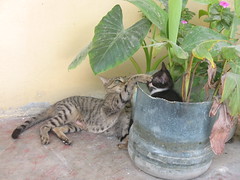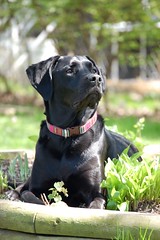 I have 2 main loves in my life (aside from my husband and family, of course): My pets, or furchildren as I like to call them, and gardening. From time to time these two loves clash. Most of my friends’ cats don’t bother the garden or the houseplants. Mine, on the other hand, have a knack for grazing on just about everything in sight. My dogs are equally mischievous. I can’t count the number of times that I’ve gotten up in the middle of the night to hear a crash in the kitchen only to find a beloved houseplant lying on the floor, dirt everywhere, and the culprit(s) nowhere to be found or found a pup trotting towards me in the yard with a seedling or two in tow.
I have 2 main loves in my life (aside from my husband and family, of course): My pets, or furchildren as I like to call them, and gardening. From time to time these two loves clash. Most of my friends’ cats don’t bother the garden or the houseplants. Mine, on the other hand, have a knack for grazing on just about everything in sight. My dogs are equally mischievous. I can’t count the number of times that I’ve gotten up in the middle of the night to hear a crash in the kitchen only to find a beloved houseplant lying on the floor, dirt everywhere, and the culprit(s) nowhere to be found or found a pup trotting towards me in the yard with a seedling or two in tow.
So what is a plant enthusiast to do? First and foremost I always consider the safety and health of my pets. Before I decide to bring home a new plant, I check the ASPA’s list of poisonous plants. The list may seem daunting at first, but there are still a lot of plants that you can bring into your home or garden that are safe for pets. Another thing to consider is that some plants are only mildly toxic to pets, while others can be highly toxic.
 Secondly I do a mental check of where the plant will reside in my home or garden, and determine if those areas are accessible to my pets. There are few places inside my house that my cats can’t reach, but they do exist, and that is where my most prized plants reside. I also have a lot of hanging baskets that the cats can’t reach. I’ve unofficially classified my dogs as ‘diggers’ and because I know their behavior around potted plants usually leads to a muddy disaster in my house, I avoid placing plants in dog territory at dog level. A lot of keeping the peace between pets and plants requires proactive planning.
Secondly I do a mental check of where the plant will reside in my home or garden, and determine if those areas are accessible to my pets. There are few places inside my house that my cats can’t reach, but they do exist, and that is where my most prized plants reside. I also have a lot of hanging baskets that the cats can’t reach. I’ve unofficially classified my dogs as ‘diggers’ and because I know their behavior around potted plants usually leads to a muddy disaster in my house, I avoid placing plants in dog territory at dog level. A lot of keeping the peace between pets and plants requires proactive planning.
My third approach helps with my cats grazing on houseplants in their reach. I have given them their own miniature ‘kitty garden’ so to speak. There are several herbs and grasses that cats are attracted to, and you can use this to your benefit. Plant a small herb garden with cat grasses and other cat-safe herbs and place it within easy reach of your cats, although it is best to make sure the seedlings are mature and rooted enough to handle chewing and grazing or the garden won’t survive long-term. Catnip can also be used, but in my experience cats won’t leave this plant alone, and it doesn’t survive the feline torment for very long.
If kitty (or puppy) still chews on the leaves of your houseplants you can take make them less appealing by applying a bad-tasting substance to the leaves, such as bitter apple or Tabasco sauce. It may take a little while to determine which deterrent is most effective for your particular pets. Make sure to reapply periodically until your pet ‘gets the hint’.
You can also deter other bad habits your pets might have with your houseplants, such as digging or tipping over the pots. Use a heavy ceramic pot with a wide base, as they are much less likely to tip over. For digging, you can fashion a ‘cover’ for the top of the plants by using a clear plastic drip tray, cutting a hole in the middle large enough for your plant to come through the top, but not too large that the soil is overly exposed. Add a few small air holes in the drip pan so that the soil has adequate airflow to dry out in-between waterings. Another solution is to cover the top layer of soil with large decorative river rocks, which can be more appealing than a plastic covering. Some cats are discouraged by placing tin foil over the pot as well.
If you’d prefer that your pets don’t approach your plants at all, consider using a deterrent like a training mat. They have small discomfort points that are unpleasant to walk across. Some mats carry a small static charge that also discourage going near the mat.
 A common problem with outdoor gardens is male dogs marking trees and plants, leading to the eventual death of your outdoor plants. Try to train your dogs to go to the bathroom in a certain area of your yard. A tool to help with this is a Pee Post. Place the stake in your yard, away from your prized plants, and encourage your pets to go to the bathroom near it. The pheromones on the Pee Post also encourage your dog to mark that area.
A common problem with outdoor gardens is male dogs marking trees and plants, leading to the eventual death of your outdoor plants. Try to train your dogs to go to the bathroom in a certain area of your yard. A tool to help with this is a Pee Post. Place the stake in your yard, away from your prized plants, and encourage your pets to go to the bathroom near it. The pheromones on the Pee Post also encourage your dog to mark that area.
The pet lover who also craves a lush indoor or outdoor garden has a little bit of extra work to do, but can absolutely be successful in their endeavors. You may have to try a combination of the methods described in this post, but with a little extra planning and preparation you can help your pets and plants to live in harmony.
 That Pet Blog That Pet Place Pet Blog
That Pet Blog That Pet Place Pet Blog
